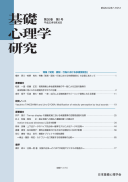Volume 15, Issue 2
Displaying 1-10 of 10 articles from this issue
- |<
- <
- 1
- >
- >|
-
Article type: Cover
1997Volume 15Issue 2 Pages Cover3-
Published: March 31, 1997
Released on J-STAGE: November 16, 2016
Download PDF (27K) -
Article type: Cover
1997Volume 15Issue 2 Pages Cover5-
Published: March 31, 1997
Released on J-STAGE: November 16, 2016
Download PDF (52K) -
Article type: Article
1997Volume 15Issue 2 Pages 69-76
Published: March 31, 1997
Released on J-STAGE: November 16, 2016
Download PDF (1075K) -
Article type: Article
1997Volume 15Issue 2 Pages 77-87
Published: March 31, 1997
Released on J-STAGE: November 16, 2016
Download PDF (1139K) -
Article type: Article
1997Volume 15Issue 2 Pages 89-101
Published: March 31, 1997
Released on J-STAGE: November 16, 2016
Download PDF (1480K) -
Article type: Article
1997Volume 15Issue 2 Pages 103-108
Published: March 31, 1997
Released on J-STAGE: November 16, 2016
Download PDF (635K) -
Article type: Article
1997Volume 15Issue 2 Pages 109-115
Published: March 31, 1997
Released on J-STAGE: November 16, 2016
Download PDF (733K) -
Article type: Article
1997Volume 15Issue 2 Pages 116-122
Published: March 31, 1997
Released on J-STAGE: November 16, 2016
Download PDF (818K) -
Article type: Article
1997Volume 15Issue 2 Pages 122-127
Published: March 31, 1997
Released on J-STAGE: November 16, 2016
Download PDF (631K) -
Article type: Article
1997Volume 15Issue 2 Pages 129-130
Published: March 31, 1997
Released on J-STAGE: November 16, 2016
Download PDF (250K)
- |<
- <
- 1
- >
- >|
